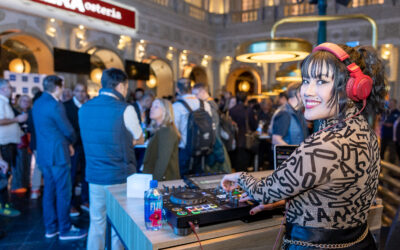
People are extremely literal. A major drawback to trade show exhibits is that you can typically only display a product, losing out on the real world context. With all of the distractions and unrealistic settings at trade shows, it can be hard for attendees to make an accurate mental connection.
Taking an attendee away from those distractions and putting them into a real life environment via experiential design helps them focus on how your products meet their needs, which in turn makes your products stand out.
The good news is that you don’t have to actually take attendees out of the convention center. You can do this in a number of ways with visual, auditory, and emotional cues created by the experience within the space (bonus points if you tap into all the senses.)
Even without the ability to recreate large or out-of-element settings to scale, experiential design and creative fabrication can mimic reality well enough to mentally place attendees in the time and place they will use your product.
Successful exhibitors have used lighting, graphics, props, sounds, and even smells to their advantage. And with the explosion of new tech options, you can immerse attendees in a virtual experience that’s hard to tell from the real thing.
Imagined Environments
From 3D content to augmented reality (AR) and LED tunnels, exhibit designers can now transport participants off the show floor and into simulations of everything from surgical suites to construction job sites. This tech-enabled freedom can remove most of the old constraints of physical realities.
The Benefits
Experiential design can increase impact and ROI in meaningful ways. Here’s why:
- Better understanding. As much as your trade show demos seem obvious, creating an experience that matches real-world context helps attendees tie your offering to their needs.
- Lower costs. At a show like ProMat or other heavy equipment shows, substituting digital assets for physical ones all but eliminates the cost of transporting equipment and material handling to the trade show and placing it in your booth. And if you’re creating digital assets, you might be able to use these assets in the field as well helping bring that real-world context with you everywhere you go.
- Easier data collection. Digital design can make collecting visitors’ info a natural part of the experience instead of a separate step. You can measure things like dwell time (time spent is a clear indicator of a positive experience) and you’ll know exactly which moments were most impactful.
- More choices. Physical assets can take up a lot of expensive space. Adding digital elements allows you to optimize booth size based on your needs and goals.
Bits and Bytes Not Required
Digital isn’t the only option for adding real-life context to your exhibit, and it’s not a new concept either. A little throwback to ProMat 2013, Yale transported visitors from the show floor to their own warehouses without having to leave their exhibit space. Sample palettes, shelving units, and industrial flooring helped show their forklifts in the proper working environments.
An added bonus came from branding the structure by housing Yale stress balls in some palettes, creating a framework out of racks for sheer branded graphics, and highlighting the trucks with LED lights under the machines.

While the possibilities are exciting, it’s important to remember that a great experience that only grabs eyes for a moment is a wasted investment. You should evaluate any experience in terms of whether it moves prospects toward your objectives.
Consider this question for your next trade show exhibit— how will you draw attention and get attendees to think about your products when they are considering options after the show?


